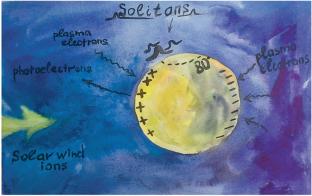月球上带电的尘埃
IF 0.8
4区 物理与天体物理
Q4 ASTRONOMY & ASTROPHYSICS
引用次数: 0
摘要
我们描述了存在于月球表面附近的等离子体尘埃系统,并考虑了在各种情况下,包括月球在地球磁尾内部或外部时,该系统中可能出现的波和不稳定性。解释了月球近表面等离子体中尘埃粒子带电的机理。注意到太阳辐射和光电子对尘埃粒子带电的影响。本文章由计算机程序翻译,如有差异,请以英文原文为准。

Charged Dust on the Moon
We describe the plasma–dust system existing near the surface of the Moon and consider the waves and instabilities that can arise in this system in various situations, including when the Moon is inside or outside the Earth’s magnetotail. The mechanism of the charging of dust particles in the near-surface plasma on the Moon is explained. The influence of solar radiation and photoelectrons on the charging of dust particles is noted.
求助全文
通过发布文献求助,成功后即可免费获取论文全文。
去求助
来源期刊

Solar System Research
地学天文-天文与天体物理
CiteScore
1.60
自引率
33.30%
发文量
32
审稿时长
6-12 weeks
期刊介绍:
Solar System Research publishes articles concerning the bodies of the Solar System, i.e., planets and their satellites, asteroids, comets, meteoric substances, and cosmic dust. The articles consider physics, dynamics and composition of these bodies, and techniques of their exploration. The journal addresses the problems of comparative planetology, physics of the planetary atmospheres and interiors, cosmochemistry, as well as planetary plasma environment and heliosphere, specifically those related to solar-planetary interactions. Attention is paid to studies of exoplanets and complex problems of the origin and evolution of planetary systems including the solar system, based on the results of astronomical observations, laboratory studies of meteorites, relevant theoretical approaches and mathematical modeling. Alongside with the original results of experimental and theoretical studies, the journal publishes scientific reviews in the field of planetary exploration, and notes on observational results.
 求助内容:
求助内容: 应助结果提醒方式:
应助结果提醒方式:


